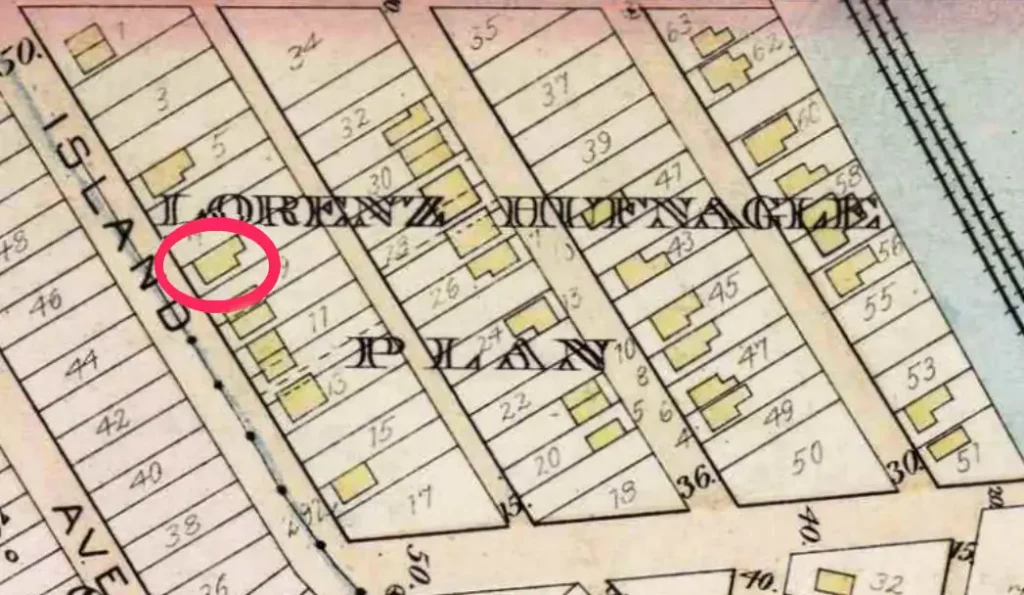
Modest frame houses with spectacular views across the Allegheny.

Modest frame houses with spectacular views across the Allegheny.

In the 1880s, the old Lorenz Hufnagle property was sold off in lots and built over with little frame houses like this.

Later, when Island Avenue became a commercial district, the little frame houses were replaced by storefronts and apartment buildings—except this one, which survived almost unaltered. At some point it was sheathed in diamond asbestos-cement shingles, which are nearly perfectly preserved. It would probably cost a fortune to remove them because of the asbestos, but in this stable state they pose no danger.

In other cities, this lot would be unbuildable. In Pittsburgh, we just have to make some adaptations. The house (now divided into three units) has a garage around the back on the left side (where you can’t see it in this picture). Suppose you were on the ground floor, meaning the floor that is level with the street in front, and you decided to go down to your car in the garage. You would have to go down into the basement. Then you would have to go down into the other basement. Then you would have to go down into the other other basement, where the garage is. Then you would have to back your car down the steep slope from the garage to the street. Altogether, there are six levels to this house in back, though only three in front. Gaining three storeys from front to back is unusual for a house in most places; in Pittsburgh, it’s just the way we deal with the topography God gave us.

Some variants on the Pittsburgh Foursquare from one block in Beechview. They all have the same basic layout of reception hall, parlor, dining room, and kitchen on the ground floor; three or four bedrooms and bathroom on the second floor; and two or more rooms on the third floor. Above, a fairly late version, probably from the 1920s. The lines are simpler and the roof is shallower.

Here is a well-preserved larger version with its original slate roof and multiple dormers. Note the arched window in the dormer. The bay on the left side of the house, which goes up from the dining room into the master bedroom, is very common in Pittsburgh Foursquares of the early 1900s. It allows cross-ventilation and ample light into those rooms in spite of the narrowness of the gap between houses.




This variant without the pyramid roof creates more room in the third floor.

A very large example of the Pittsburgh Foursquare, but the layout of rooms is more or less the same; they are just bigger rooms.

Finally, a much-renovated house with a gambrel roof, which probably has more room on the third floor in proportion to its size than any of the others.

A row of houses in different styles, all of them typical of the South Side.

We’ve seen these two tiny frame houses before. They date from the Civil War era, and unlike almost all the others of their type and age on the South Side they retain their wood siding. The one on the left is an odd shape: there is a kink in the South Side street grid at 24th street, so the alley does not meet the street at a right angle.

This eclectic Victorian has a large dormer on the fourth floor, and another thing that is sort of a dormer, but not exactly, projecting from the roof and lining up with a slightly extended section, giving the house the effect of a three-storey tower.

Florida Avenue runs parallel to Washington Road, the main spine street of Mount Lebanon. The part behind the Uptown business district has a mixture of apartment building from small to large, double houses, and single-family homes, all assorted randomly. The next block to the south is mostly single-family homes in the wide range of styles typical of the Mount Lebanon Historic District. We have already seen some of the apartment buildings; here are some of the single and double houses.



This eclectic house in the fairy-tale style sits on a corner and presents quite different faces to the two streets. Above, a lavishly asymmetrical Tudor face on one side; below, the very symmetrical French-country-house face around the corner.



A twin house, with two houses side by side that are identical except for being mirror images.

A double house where the two units are deliberately made different, so that at first glance it appears to be a single larger house.

Steel baron B. F. Jones’ front doorway is a feast of elaborate terra cotta. This is a very large picture: enlarge it to appreciate the details of the terra cotta and ironwork.

This row of houses on Howe Street has a distinctly Dutch or Flemish look. The Flemish style is not unknown in Pittsburgh, but it is rare to see a row of five houses in that style at once. (For another example of multiple Flemish houses, see the Osterling row in Brighton Heights.)

This house, like many in Shadyside, has had part of its basement turned into a garage, with a steep driveway dug out of the front yard.

It is delightful to see that the intricate woodwork on the front porch has been preserved.


The angles and curves that make the gable look so Antverpian are made of iron or steel, as we can tell by one rusted section:

This makes us suspect that perhaps three of the other houses in the row might have had similar decorations, removed when they rusted too much to repair.



This house, however, was clearly meant to show off its stones without additional adornment, except for the usual decorative utility-cable swags.